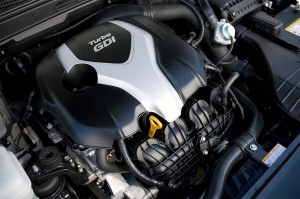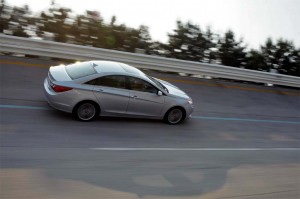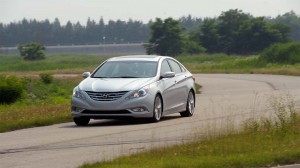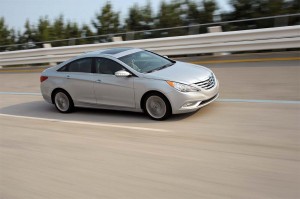Hyundai has had a way of defying expectations. In its early years in the U.S. market it undercut the Japanese on price. And then, when it seemed that price alone wasn’t enough, it took steps to correct its quality problems, backing that up with the industry’s best warranty. Known for its cheap-and-cheerful small cars, the Korean carmaker swatted a home run with its first-ever luxury model, the Genesis sedan, winning the coveted North American Car of the Year trophy, in the process.
Hyundai served up another ace – to mix our sports metaphors – when it launched the sixth-generation Sonata sedan for 2010. Roomy, affordable and arguably the best-looking model in the midsize segment, it delivered another surprise by offering buyers only a peppy, fuel-efficient inline-four engine. No V6s now or later, Hyundai officials declared.
But they did hint that a couple other powertrain offerings were on the horizon, and TheDetroitBureau.com got to check both of them out during a trip to South Korea and a visit to the maker’s Namyang Proving Grounds. We’ll have a review of the 2011 Hyundai Sonata Hybrid – the maker’s first gas-electric offering – next week. But let’s start with a look at the 2011 Hyundai Sonata 2.0T.
The Sonata turbo delivers a one-word answer to the nagging question: does a maker need to offer a V6 for a midsize sedan. “No.” Make that “N-O. “ With 274 horsepower and 269 pound-feet of torque, the 2.0T blows off just about anything you can think of in its class, whether turbocharged or naturally aspirated. And yet, with a forecasted 22 mpg City, 34 Highway, it’s right up there with the best-in-class for mileage, as well.

Making 274 horsepower and 269 pound-feet, Hyundai expects the 2.0T to still deliver 34 mpg on the highway.
What surprises us is Hyundai’s decision to make this powertrain virtually invisible to the outside world. A passerby will have to look closely to spot the modest 2.0T badge on the back and the big Panorama sunroof. (While we were in Korea, company officials seemed interested in our opinion about the lack of aggressive badging or distinctive body detailing, however, so we may yet see a little more distinctive identification by the time the 2011 Hyundai Sonata 2.0T rolls into showrooms.)
Admittedly, that’s not all bad. We’ve seen makers clap out a performance model with all sorts of unnecessary accouterments before – think Pontiac – and that would be all the more the shame considering the classic good looks of the “base” Sonata. Yet we’ve also seen the dramatic design details the maker has come up with for the Sonata Hybrid. Perhaps a mid-cycle update will be due, Hyundai?
Hyundai also sticks with the standard-edition interior. That’s not a bad move, of course, as the cabin has been refined significantly from the prior-generation Sonata and is now, to our eyes and hands, a more lavish and well-executed design than most of what the Japanese have been bringing to market. Notably, while makers like Toyota seem to be looking for corners to cut, Hyundai has clearly invested in the Sonata’s interior.
If we have any single complaint it’s about seating. Sure, they are roomy, both front and back, but they are not the most comfortable seats for extended driving, as we discovered on a day-long trip with the original ’11 Sonata. We’d certainly love to see more bolstering to hold us in place when we push the Sonata 2.0T to its limits.

Surprisingly, Hyundai has chosen to do little to distinguish the turbo Sonata from the base 2.4-liter car beyond a small 2.0T badge.
And you have to push hard. Preliminary specs suggest 0 to 60 times of 6.5 seconds, which blows away the segment’s other turbos. As for top speed? Well, we briefly had the Sonata 2.0T up to 150 mph as we looped the long Namyang track, a steeply-banked oval.
What was impressive was the stability of the car in the corners, even when we decided to ride the lower line at more than 110 mph, not taking advantage of the bank.
Hyundai’s approach to the new Sonata suggests it’s not quite ready to target the true performance sport sedan niche, which is too bad. But for those who want to maximize the fun factor with the car, there’s the 2.0T SE, which gives you monotube shocks, larger anti-sway bars, performance 18-inch tires and stiffer springs.
Now it just needs a Sport Mode setting.
For those who want the technical details, the 2011 Hyundai Sonata 2.0T is powered by a new 2.0-liter version of the Theta engine, a downsized version of the standard-issue 2.4-liter I4. It’s outfitted with a twin-scroll turbo and an electronically-controlled wastegate actuator, which is meant to both improve efficiency, maximize performance and speed up so-called catalytic convertor light-off.

Hyundai plans to offer three powertrains for the 2011 Sonata, the base 2.4, the 2.0T turbo and its first-ever gas-electric hybrid.
As with the 2.4, the Turbo is fitted with an in-house-developed 6-speed automatic. We’d love to see a stick or double-clutch, but it’s a reasonable smooth and quick-shifting gearbox.
Our drive was relatively limited, so we couldn’t get much sense of what the Sonata 2.0T will feel like in either Seoul traffic or on rutted Michigan roadways. But considering the relatively minor changes other than the engine package, we expect this new Hyundai offering to drive much like the base Sonata. It’s a comfortable car, easy to handle and well-mannered when driven hard, though it has more in common with the soft, mainstream feel of a Toyota Camry than the more aggressive ride and handling of the new, 2011 Buick Regal, one of our midsize favorites when it comes to driving dynamics.
We’ll be waiting for final mileage numbers – and to see if the folks from Seoul can deliver at the promised $25,000. But barring some unpleasant surprise on mileage or pricing, the 2011 Hyundai Sonata 2.0T only enhances the appeal of the Korean carmaker’s latest midsize entry. If anything, we now expect Hyundai to deliver some of the best products on the market. Here, the maker has lived up to expectations.

